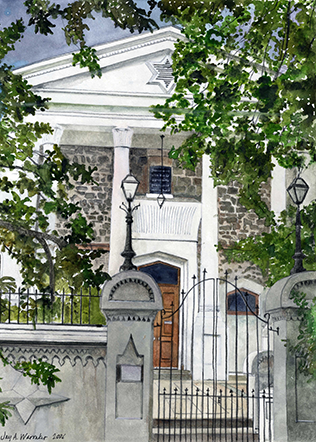 Exterior View (2005), 11” x 15” Watercolor, Jay A. Waronker
Exterior View (2005), 11” x 15” Watercolor, Jay A. Waronker
south africa
Old Gardens Synagogue, also known as Tikvat Yisrael (Hope of Israel)(Completed in 1863) |
|

Interior View (2005), 11” x 15” Watercolor, Jay A. Waronker
|
Two historic synagogues positioned literally next to each other can be found in the attractive and popular Gardens district of Cape Town, an inner-suburb of the city located just to the south of the central business district and within the higher elevations of the City Bowl. To the north in the distance is the spectacular Table Mountain, which serves as a natural background to this entire site. The Gardens district dates to the mid-17th century when the first garden was laid out. Over the years, the gardens have been changed and expanded, and the district became home to a number of important buildings and monuments. Among these include the Parliament Building down the street on Government Avenue along with the National Library, President’s Residence, South African Museum, National Art Gallery, Michaelis School of Fine Arts, Planetarium, and the Old Gardens and New Gardens Synagogues.
The Gardens Synagogue, more formally named the Tikvat Yisrael Congregation, got its start in 1841, making it the oldest in South Africa and one of the oldest in the Southern hemisphere. The name of the congregation, which means “Hope of Israel" in English, could be regarded as fitting reference to South Africa’s greatest natural site, the Cape of Good Hope. On the eve of Yom Kippur of that year, the first prayer services were held in Helmsley Place on Hof Street, which today forms part of the venerable Mount Nelson Hotel. It was on this day that the Cape Town Hebrew Congregation was formally founded by seventeen male members. The congregation grew slowly, and by 1849 the community was able to purchase a modest house that they converted into a synagogue.
By the early 1860s, a larger and more complete synagogue was needed, and a prominent site in the heart of the Gardens district was purchased. Work soon began on the building, and it was consecrated on September 13, 1863. What was realized on the property was a stone and painted white plaster building featuring a neo-classical front pediment, yet its hexastyle columns set on robust plinths and other architectural details are not classically-pure but stylized and eclectic. The over panel at the front door and the lotus column capitals seem to borrow from ancient Egyptian design. Fronting the building along the gardens promenade, a wrought iron gate set within masonry posts was constructed, and it survives today.
On the interior, a beautiful sanctuary was realized with its white plaster interior contrasted by stained wood paneling and other architectural detailing. A landmark structure in Cape Town for both the Jewish and wider South African communities, since 1958 the building has functioned as the South African Jewish Museum. Whereas the floor area of the sanctuary once containing seating for the members now displays museum pieces in exhibition cases, the original ark set in a decorated semicircular plaster and paneled-wood niche survives clearly as a remnant of the original function of the building.
